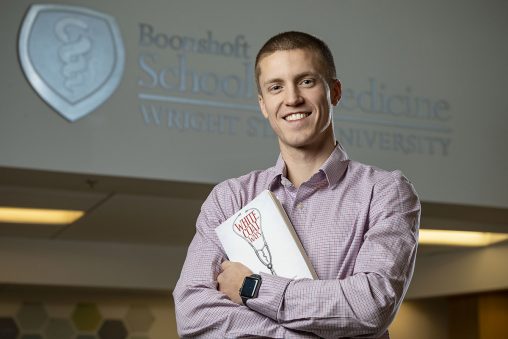
Brian Elliott, an Air Force captain and internal medicine chief resident, examines the history and effectiveness of medical traditions in “White Coat Ways: A History of Medical Traditions and Their Battle with Progress.”
Think of physicians and others in the medical profession and white lab coats come to mind. But why do they wear white coats? And should they?
Those are the questions addressed by Brian Elliott, M.D., in his recently released book, “White Coat Ways: A History of Medical Traditions and Their Battle with Progress.”
Elliott is an Air Force captain who is internal medicine chief resident at Wright-Patterson Medical Center, affiliated with the Wright State University Boonshoft School of Medicine. He also is a clinical instructor and assistant professor of medicine at the Boonshoft School of Medicine.
“Medicine is filled with tradition,” Elliott said. “This book is about why, and whether they should continue.”
Elliott started research into what became the book in 2018, when he was in medical school at Thomas Jefferson University in Philadelphia, near where he was born and raised in southern New Jersey. He originally had intended to write an article for a professional journal, but his interest in the subject grew and, he said, “I found I had a lot more to say.”
How did he as a medical student also manage to do book research? ”When you care about something that much, you carve out time here and there,” he said.
Elliott wrote the book — quickly crediting his wife, Laura, for her help — and employed a professional firm to do the editing. He self-published the book in paperback through Med Media Publishing LLC available through a variety of online retailers.
The book goes into detail about seven traditions, the most recognizable, he said, is the title subject, the white coat. “It’s a tradition that’s so ingrained. When we think of a doctor, you think of a man or woman in a white coat,” he said. “The irony is that we’ve forgotten how it started.”
Elliott said in the early days of medicine, there was little attention to cleanliness. As medicine advanced, it became common for doctors to wear a white coat, which was thought to be antiseptic and showed that the wearer was keeping clean.
But white lab coats carry bacteria picked up in health care settings and aren’t as pristine as people think, Elliott said, and can cause patients to be infected. Still, the tradition endures. He said he instead tends to wear scrubs without sleeves, so he can wash his hand and arms regularly.
Another tradition related to the initial donning of the white coat is medical students taking the Hippocratic Oath during their official ceremony bestowing the title of doctor. “Hippocrates likely didn’t write it,” he said.
And while it’s thought to have been handed down for more than 2,000 years, Elliott said it didn’t catch on popularly until the 20th century. The wording of the oath — generally for the physician to do no harm to a patient and to set down ethical concepts — varies from medical school to medical school, he said.
While he questions these and other traditions, Elliott is not against all of them.
In particular, he believes in the cadaver lab, where students dissect the recently deceased to learn the inner anatomy. Such labs were commonplace but fell out of favor in place of technology that allows seeing inside the body without being invasive. Elliott said there’s a benefit for medical students to study cadavers.
And despite his questioning the wisdom of the white coat, he sees the positive in that tradition.
“Patients find that that coat symbolizes professionalism” and can put their minds at ease, he said.
Still, his book is “not about whether to get rid of all these traditions, but do we do them because we’ve always done them or because they make sense.”
Reactions have been positive in an early release of his book to the medical community. The book is aimed not only at those in the medical field.
“I wrote it in a way that it’s easily understandable to the general public — to anyone interested in the topic,” he said.
For now, Elliott is wrapping up his time at Wright-Patterson Medical Center. This summer he will move to Walter Reed National Military Medical Center in Maryland where he will be stationed for three years.
“I’ll likely come back here, but it’s up to the Air Force,” he said. “I very much enjoyed my time here in residency. I’ve had phenomenal mentorship, which allowed me to do things like this book in addition to clinical duties.”
Will there be a follow-up book? “For now, I’m focused on this launch,” Elliott said. “But I have an idea for book number two if things go well.”

 Bags, boards and bonding
Bags, boards and bonding  More than 1,000 students to graduate at Wright State’s fall commencement ceremonies
More than 1,000 students to graduate at Wright State’s fall commencement ceremonies  Wright State’s Take Flight Program helps students soar high
Wright State’s Take Flight Program helps students soar high  Wright State Police Department delivers major donation to Raider Food Pantry
Wright State Police Department delivers major donation to Raider Food Pantry  Wright State engineering and computer science students earn prestigious federal SMART Scholarships
Wright State engineering and computer science students earn prestigious federal SMART Scholarships 